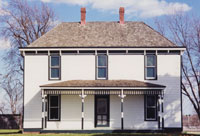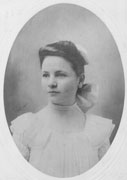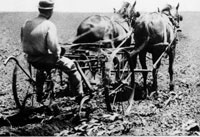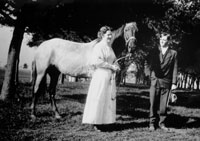Two years after Solomon Young died in 1892, the grand house that he had built on his farm burned down. Louisa Young, his widow, and his son Harrison replaced it with a smaller house, built in 1894-95, probably in two phases. The new house was built on a portion of the old foundation. Mary Jane Truman, Truman’s sister (pictured below right), described the old house as "really a nice old pre-Civil War house"--actually it was for the most part built just after the war--but the new one, she felt, "was just kind of thrown together. It wasn’t the same kind of a house that the old house was." (Mary Jane Truman oral history interview, Truman Library, 1976.) The house was situated about a half mile east of Grandview Road. One entered the property from Grandview Road through the old churchyard of the Grandview Baptist Church--the church itself was moved to a new location in Grandview, about a mile south, in 1891--and then through a large grove of maple trees planted in parallel rows. During the road building program that was undertaken when Truman was presiding judge of Jackson County, Blue Ridge Boulevard was extended to the south in such a way that it passed between the farmhouse and the churchyard, providing much improved access to the property from the main road system.
After spending many weekends at the Grandview farm in 1905 and 1906--during which time his parents had moved to the farm--Truman moved to the farm in 1906 to help his family. The farm comprised about 600 acres--nearly a square mile--much reduced from the approximately 1,500 acres that belonged to Truman's grandfather Solomon Young when he died in 1892. It was still a large farm by contemporary Missouri standards, and the land was probably worth about $100,000 in 1914. Truman reflected in later years on his unlikely transformation from banker to farmer: "...All sorts of wagers were made that I wouldn't stay over ten days--two weeks--a month--a year at the outside. I stayed ten years.... I thought maybe by cussing mules and plowing corn I could perhaps overcome my shyness and amount to something." (Handwritten autobiographical manuscript, ca. late 1930s, Truman's papers as Senator and Vice President.) Truman shared an upstairs bedroom with his brother J. Vivian Truman and, after his brother married and moved away in 1911, with hired hands.
Although he stayed on the farm for a long time, Truman may never have completely adapted to what in his day and place was a typical farmer’s life. Stephen Slaughter, who lived on the farm adjacent on the north to the Young/Truman farm, remembered the first time he ever saw Truman. He was about five or six years old, and Truman had just come to the farm. "...Harry was standing up in a bundle wagon, and he had a white Panama hat on. It was a soft hat, but a Panama, white... It was different from what most of them wore. Harry never looked unkempt." Truman never wore bib overalls; he didn’t look like other farmers. "He worked in the fields from time to time," Slaughter recalled, "but he was never a regular part of the farm work force. Not as I remember it. He helped his mother. He played the piano; he’d talk; he’d go around and oversee things a bit." (Stephen S. Slaughter oral history interview, 1984.) Another neighbor, Gaylon Babcock, who was not friendly to Truman then or later, called him "his mother’s pet." He might work on the bundle wagon for a time and then move on to something else. "In fact, he had no set place to work, I mean, he may be doing that job one day and maybe something else on another day. He was not known as a bundle wagon man. Or, he might drive a grain wagon, you see. Frankly, he didn’t stay on the job very steadily. I’ll tell you that... He might be considered more of a utility man to fill different places... And, he did help a lot in his own home [serving meals to the field hands]... And...it was his habit, if we had some extra time around noon, not to be out with the men, joking and talking, but to go and play the piano. Something like this was more appealing to him." (Gaylon Babcock oral history interview, 1964.)
Truman was unlike most other farmers in another respect as well. When Stephen Slaughter first met Truman, he recognized that he had "a personality and charisma." When Truman first came to the Grandview farm, when he would visit the Slaughter farm, people thought about him after he left, and they talked about him. "It was all complimentary... I remember that. As a kid I listened." Truman’s cousin, Mary Ethel Noland, who knew her cousin very well, thought that the farm was only a passing interlude in his life. "We didn’t feel that he would spend his life on the farm. All this about plowing a straight row and all of that--he was a farmer, but Harry sort of had an eye on urban affairs, I would say." (Mary Ethel Noland oral history interview, Truman Library, 1965.)
In June 1917, Truman enlisted in the National Guard and he left the farm for service in France soon after. He returned to the farm when he was separated from the Army on May 6, 1919 and lived there until he married Bess Wallace on June 28, 1919. After returning from his honeymoon, he moved in with Bess and Madge Wallace at 219 N. Delaware Street in Independence.
Truman wanted his sister, Mary Jane Truman, who had run the farm while he was in the Army, to continue running it after he married. She didn’t want to run it without his help, though, and Truman decided to give up farming. On September 23, 1919, the Truman family sold at auction 231 hogs, 18 horses and mules, 23 cows and calves, and farm implements. "Captain Harry Truman has decided to quit the farming game for the present," the Independence Examiner reported the day before the auction. "[He] has gone into business in Kansas City and will make his home in Independence this winter."
Truman's mother, Martha Ellen Truman, sold 200 acres to a real estate developer in 1922, and further sales reduced the farm to 287 acres by 1940. Truman’s brother, Vivian (pictured right with his wife), farmed what remained of the family land during these years. In 1940, Jackson County foreclosed on a loan to Martha Ellen Truman, and she lost the farm and moved to a house on High Grove Road in Grandview. In 1945, three of Truman's friends bought the farm from Jackson County for $43,000. They sold 87 acres and the farmhouse to J. Vivian Truman for $20,000 in 1945, and the remaining 200 acres to Harry Truman for $23,000 in 1946. Truman and his brother and sister acquired additional portions of the old family land, and by the early 1950s they together owned 529 acres. They sold most of the land in 1955 and 1958 to developers who built a shopping center and houses on the property.
Major roads which had been built through the Truman farm had made the land very valuable by the time the Trumans sold. Mary Jane Truman, who probably had very little money through most of her life, became well-to-do when she sold her share of the farm. She had an estate of about $1 million when she died in 1978. In 1980, the Department of the Interior awarded the State of Missouri $378,250 to purchase the farmhouse and 5.25 acres from the sons of J. Vivian Truman. The National Park Service acquired this property in 1994, by donation from the Jackson County Parks and Recreation Department, and made it part of the Harry S. Truman National Historic Site.
The Young-Truman Farm is located at 12301 Blue Ridge Boulevard. Its former location was on Grandview Road, about a mile north of Grandview. The farm is a National Park Service property. (816) 254-2720.



